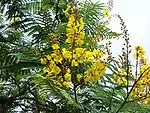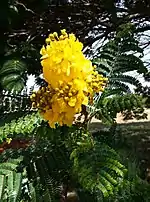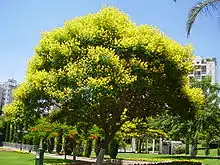Peltophorum dubium
Peltophorum dubium is a tree in the family Fabaceae and subfamily Caesalpinioideae. This species is known as the Ibirá-pitá in Argentina and Paraguay, arbol de Artigas in Uruguay, and Cambuí [1] in Brazil. It is a large tree, growing around 20–25 meters, with a rectangular trunk.
- Foliage: bright green, and deciduous
- Leaves: compound, bipinnate, large. Numerous leaves with a central nervous system.
- Flowers: from 2 cm in diameter, arranged in bundles that end in spikes. The bright visible flowers are in corollas. They flower in the summer and at the beginning of autumn.
- Fruits: indehiscent legume, flat, leathery, and brown.
- Seeds: cylindrical with hard nuts.

Flowers of Peltophorum dubium.

Close-up of flowers
| Peltophorum dubium | |
|---|---|
 | |
| Scientific classification | |
| Kingdom: | |
| (unranked): | |
| (unranked): | |
| (unranked): | |
| Order: | |
| Family: | |
| Subfamily: | |
| Tribe: | |
| Genus: | |
| Species: | P. dubium |
| Binomial name | |
| Peltophorum dubium | |
Habitat
They grow on the riverbanks in the south of Brazil, the northeast of Argentina and Paraguay and in the north of Uruguay. They have also been planted along the avenues of Buenos Aires and Montevideo. They are tropical trees, but can grow to quite large specimens in temperate climates.
References
- Braziliense, Correio (19 January 2016). "Floração dos cambuís ajuda a alegrar a paisagem das asas Sul e Norte".
External links
![]() Media related to Peltophorum dubium at Wikimedia Commons
Media related to Peltophorum dubium at Wikimedia Commons
![]() Data related to Peltophorum dubium at Wikispecies
Data related to Peltophorum dubium at Wikispecies
- "Peltophorum dubium". Germplasm Resources Information Network (GRIN). Agricultural Research Service (ARS), United States Department of Agriculture (USDA).
| Wikimedia Commons has media related to Peltophorum dubium. |
This article is issued from Wikipedia. The text is licensed under Creative Commons - Attribution - Sharealike. Additional terms may apply for the media files.